Sun Bear
Helarctos malayanus
The smallest species of bear in the world!
Advertisement
Sun Bear Scientific Classification
- Kingdom
- Animalia
- Phylum
- Chordata
- Class
- Mammalia
- Order
- Carnivora
- Family
- Ursidae
- Genus
- Helarctos
- Scientific Name
- Helarctos malayanus
Read our Complete Guide to Classification of Animals.
Sun Bear Conservation Status
Sun Bear Facts
- Prey
- Fruits, Honey, Insects
- Name Of Young
- Cub
- Group Behavior
- Solitary
- Fun Fact
- The smallest species of bear in the world!
- Estimated Population Size
- Unknown
- Biggest Threat
- Hunting and habitat loss
- Most Distinctive Feature
- Yellow or orange U-shaped marking on chest
- Other Name(s)
- Malaysian Sun Bear, Malay Bear, Honey Bear, Dog Bear
- Gestation Period
- 3 - 8 months
- Habitat
- Primarily, lowland tropical forests
- Predators
- Tiger, Snakes, Birds of Prey
- Diet
- Omnivore
- Average Litter Size
- 2
- Lifestyle
- Diurnal/Nocturnal
- Common Name
- Sun Bear
- Number Of Species
- 2
- Location
- South-east Asia
- Slogan
- The smallest species of bear in the world!
- Group
- Mammal
Sun Bear Physical Characteristics
- Color
- Brown
- Grey
- Yellow
- Red
- Black
- White
- Orange
- Skin Type
- Fur
- Top Speed
- 30 mph
- Lifespan
- 15 - 30 years
- Weight
- 30kg - 60kg (66lbs - 132lbs)
- Height
- 1.2m - 1.5m (4ft - 5ft)
- Age of Sexual Maturity
- 3 - 4 years
- Age of Weaning
- 18 months
View all of the Sun Bear images!

Sun Bear Classification and Evolution
Descended from the Black Bear, the Sun Bear has developed some unique characteristics of its own to suit its tree-dwelling and mostly herbivore lifestyle:
- Paws turned inward, flattened chest, and powerful forearms and claws for climbing trees
- A long tongue, adapted from Asian Black Bears, for reaching honey and termites in trees
- Flattened molars for grinding instead of tearing
- Loose neck skin so, if attacked, can turn its head to bite its predator
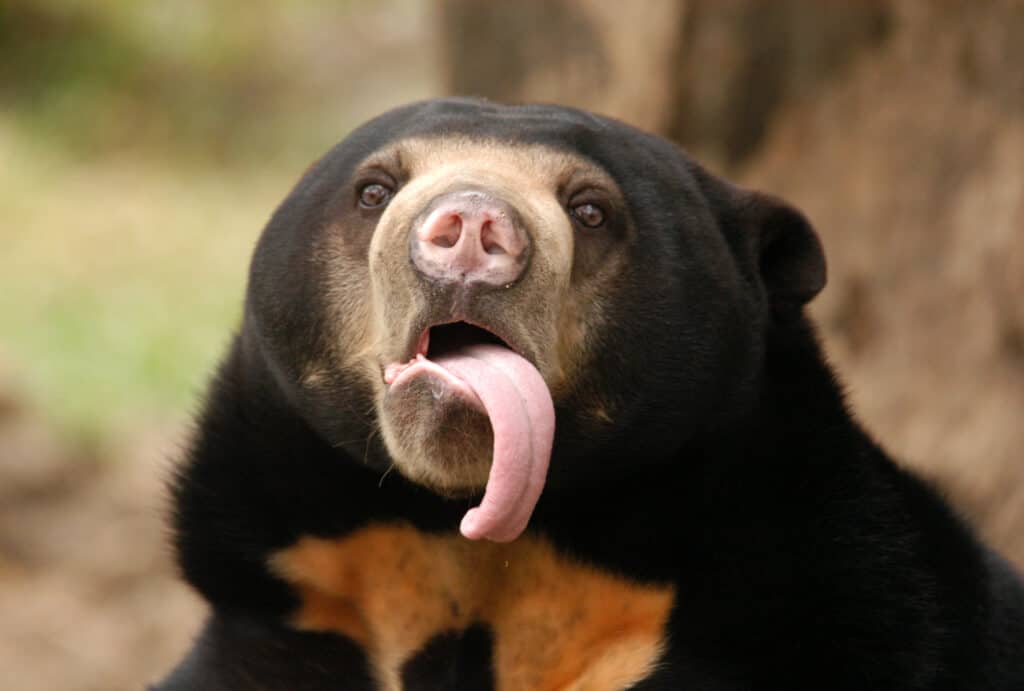
A Sun bear is a tree-dwelling bear with a very long tongue.
©Vladimir Wrangel/Shutterstock.com
Description
The Sun Bear is a small species of bear that is found inhabiting the dense, tropical forests of south-east Asia. The Sun Bear is the smallest species of bear in the world and it is also one of the most unique, being the only member of its family that has not only adapted to living in the jungle but also leads an exclusively tree-dwelling life. Also known as the Honey Bear, the Sun Bear is an animal that has a number of distinctive features, most notably the orange U-shaped marking on its chest from which it gets its name. Sun Bears are both rare and elusive animals meaning that very little is actually known about their behaviors and habits in the wild (or indeed exactly how rare they are). Populations however, are known to be drastically decreasing as Sun Bears are threatened by both hunting and habitat loss throughout much of their natural range.
Anatomy and Appearance
The Sun Bear is not only the smallest bear species in the world, but it also has the shortest fur. The sleek, glossy coat of the Sun Bear ranges from black to dark brown or grey in colour with their distinctive chest marking varying from white to yellow or orange, and can take a number of shapes including the standard crescent, a circle, or an irregular spot. The Sun Bear is an animal with a light-coloured face with a short muzzle, which along with its short fur and ears, is thought to be an adaptation to spending so much time in the trees. It also has long, curved claws on its front paws which help the animal to climb trees and break open hollow logs in search of termites, which it is also able to do with its large canines and strong jaw. One of the most remarkable features of the Sun Bear is its long tongue that can be up to 25cm long and is used to extract grubs and honey from nests and crevices.
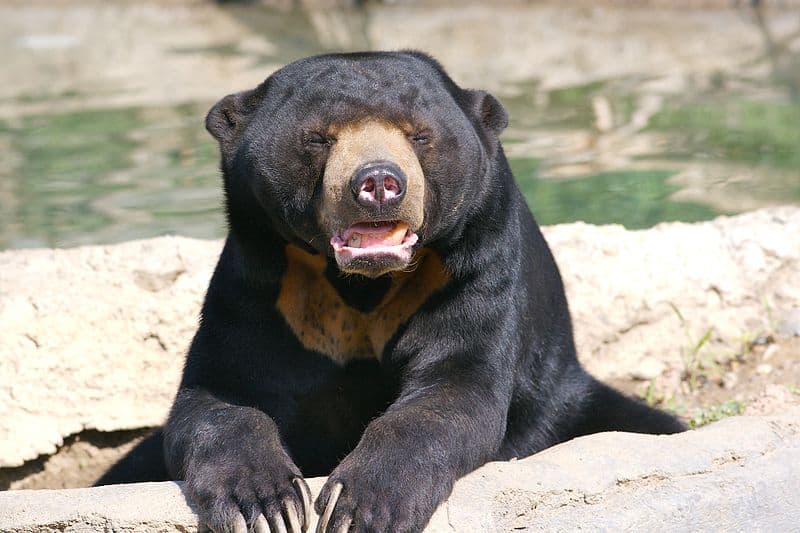
The Sun Bear in the wild lives mainly in Borneo, Sumatra, and SE Asia.
©Ryan E. Poplin / Creative Commons – License
Distribution and Habitat
The Sun Bear would have once been found throughout a number of countries in south-east Asia but due to growing Human development, they are now only found in a handful of increasingly isolated habitats. Sun Bears can be found on the islands of Borneo and Sumatra, in forests on the mainland (Malaysia, Thailand, Cambodia, Laos and Vietnam) and there are also a few remote populations of Sun Bears in eastern India and southern China. The Sun Bear inhabits primary, lowland rainforest where there are not only a wide variety of foods to eat, but also plenty of cover to remain safe from predators. However, throughout much of their natural range (but particularly in Indonesia and Malaysia) the Sun Bear has lost vast regions of its native habitats to deforestation, primarily to clear land for agriculture (such as palm oil plantations) and to cut down the rare and valuable tropical trees for the timber industry.
Behaviour and Lifestyle
The Sun Bear spends the majority of its life high in the trees. It sleeps in a nest in the canopy, which is built out by folding leafy branches over. Sun Bears are therefore incredibly adept at climbing with remarkable speed using their long, curved claws. However, Sun Bears are also known to climb trees by actually hugging the trunk with their front limbs and by gripping with their strong teeth so that they are able to haul themselves up. Oddly enough, Sun Bears are primarily diurnal animals that spend the daytime foraging for food and resting high in their tree-top nests at night. However, in areas that are being increasingly affected by growing levels of human activity, Sun Bears are known to adopt a more nocturnal way of life to avoid confrontation. Like the other bear species, Sun Bears are also solitary animals that are only really seen in each other’s company when a male and female are looking to mate.
Reproduction and Life Cycles

At birth sun bear cubs are quite small.
©iStock.com/bari paramarta
In the same way as a number of other animal species that are found in the tropics, the Sun Bear is known to both mate and give birth all year round. After a gestation period that is known to vary dramatically (between 3 and 8 months) depending on the individual and the amount of food available, the female Sun Bear gives birth to up to three cubs (but usually only one cub) in a nest that she makes in a large cavity such as a hollow tree. The young Sun Bear cubs are nursed and fiercely guarded by their mother and are taught the skills of surviving in the tropics until they become independent of her when they are nearly two years old and leave to establish their own territories. Females are usually able to reproduce when they are three years old and males a year later. Sun Bears are thought to live for an average of 25 years in the wild but have been known to be more than 30 years old in captivity.
Diet and Prey
Despite technically being a classed as a carnivore, the majority of the Sun Bears diet is comprised of fruits and other plant matter that it finds in the surrounding forest. Like other bear species, their molar teeth have lost their “flesh-shearing” capabilities and are instead flatter to help with the grinding down of vegetation. Sun Bears eat a wide variety of fruits, nuts, berries and shoots along with supplementing their diet with insects, grubs, honey, eggs, and small animals such as rodents, when plant matter is scarce. By using their strong teeth and sharp claws, Sun Bears are able to break open hollow logs before using their long tongue to extract the termites inside. However, when it is not possible to break the nest in a tree trunk, Sun Bears are known to place their front paws into the hole one at a time, allowing the termites to crawl over their paws before the Sun Bear then licks them off.
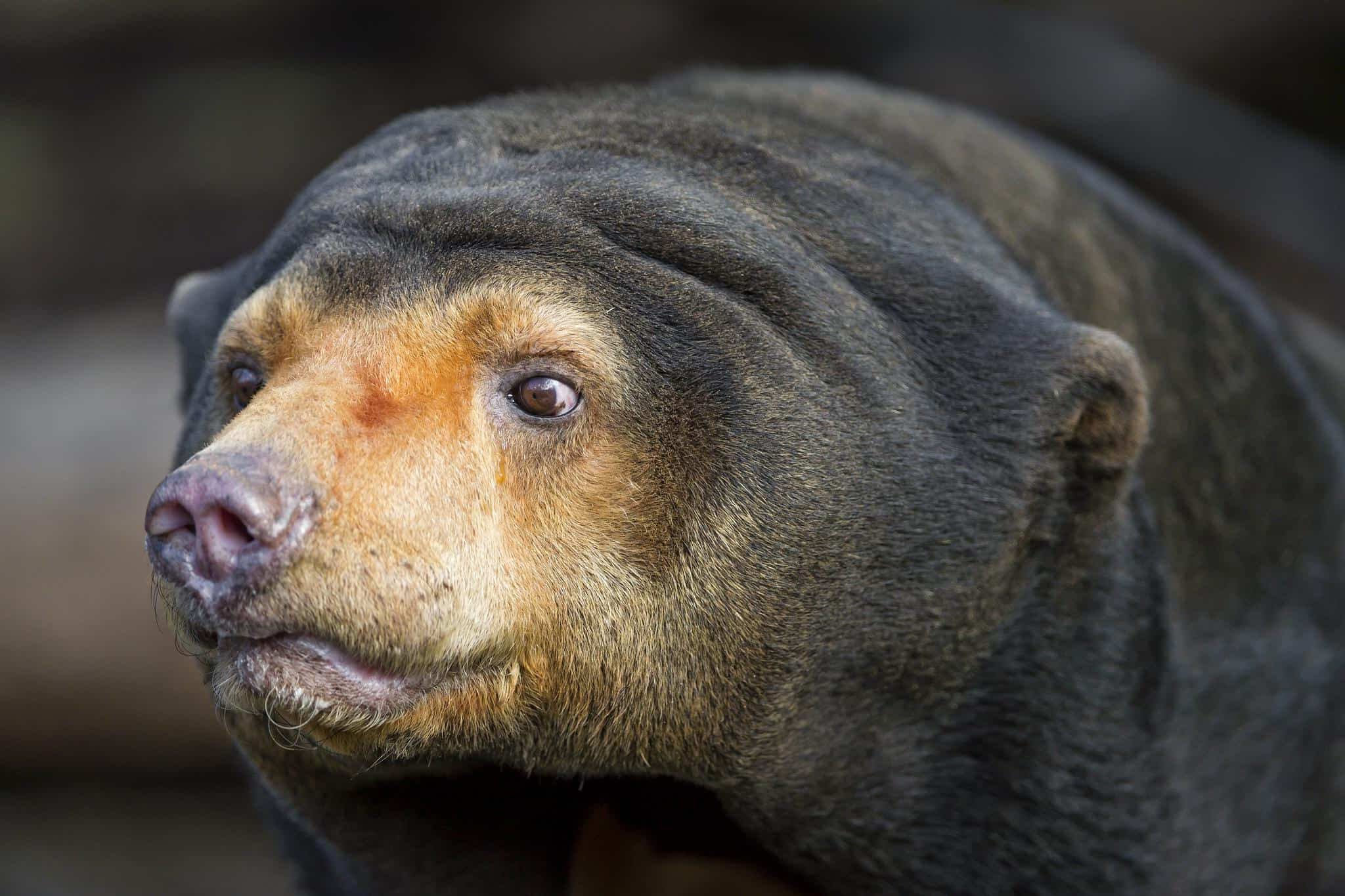
A close-up of a Sun Bear showing the loose skin around its neck..
Predators and Threats
Due to the relatively large size and tree-dwelling nature of the Sun Bear, adults have relatively few predators in their native environment. Large carnivorous animals like tigers are the main predators of the Sun Bear, but these animals have evolved another unique adaptation to help them to escape in these situations. The Sun Bear has loose skin, particularly around its neck, which means that if it is caught by a predator, it is able to still spin its head round to try and bite its attacker. Sun Bear cubs, however, are much more vulnerable and are preyed upon by a variety of jungle predators including snakes and large birds of prey. The biggest threat, though, to southeast Asia’s remaining Sun Bear populations is the drastic declines in much of their natural habitats due to deforestation. In areas where agricultural plantations encroach on their territories, Sun Bears are also known to raid oil palms, particularly to eat the young shoots. They are therefore also persecuted by farmers who fear for the stability of their crops.
Interesting Facts and Features
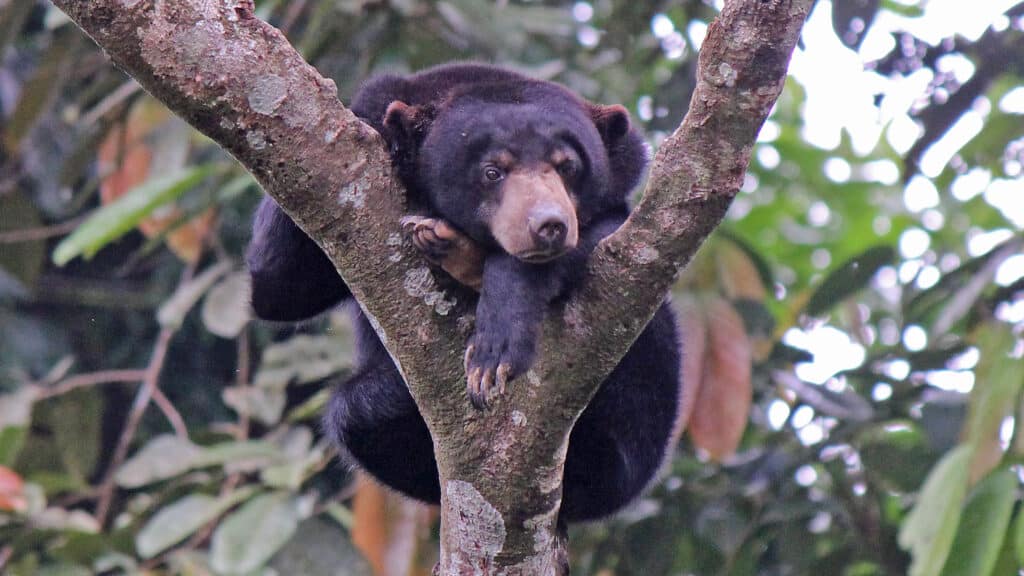
Sun bears, also known as dog bears, do not hibernate.
©iStock.com/James Moore
The Sun Bear is known by a number of different names but its small size, short snout and ears, and short, glossy fur has led it to being commonly known as the “Dog Bear” in local communities. Although the Sun Bear is generally solitary, on rare occasions a few individuals are known to congregate around ripening fruit trees and will tolerate one another while they feed. Even though Sun Bears are similar in varying parts of their natural range, there is actually a smaller recognised sub-species of Sun Bear that is found on the island of Borneo, but very little is known about it. Unlike a number of the other eight bear species around the world, the Sun Bear does not hibernate. Due to the fact that Sun Bears are found in the tropics where there are not such sweeping seasonal changes, they simply have no need to sleep through the winter months (breeding is also known to occur all year round for the same reason).
If you’re looking for more amazing sun bear facts, make sure to read ‘10 Incredible Sun Bear Facts.’
Relationship with Humans
Since modern people arrived in southeast Asia thousands of years ago, Sun Bears, as well as all other bear species, have been hunted mainly for the use of certain of their body parts. Asian medicine markets seek the gallbladder in particular. Because of their small size and generally docile nature, Sun Bears are also captured to be sold into the exotic pet market around the world. However, the biggest problem for the Sun Bear today is the fact that it has lost vast areas of its once extensive natural habitat to deforestation for logging and land clearance for agriculture (most of which is illegal). As Sun Bears spend the majority of their lives in the trees, they rely heavily on the rich, dense rainforests that they have become accustomed to, but much of it today has now disappeared with growing human activity.
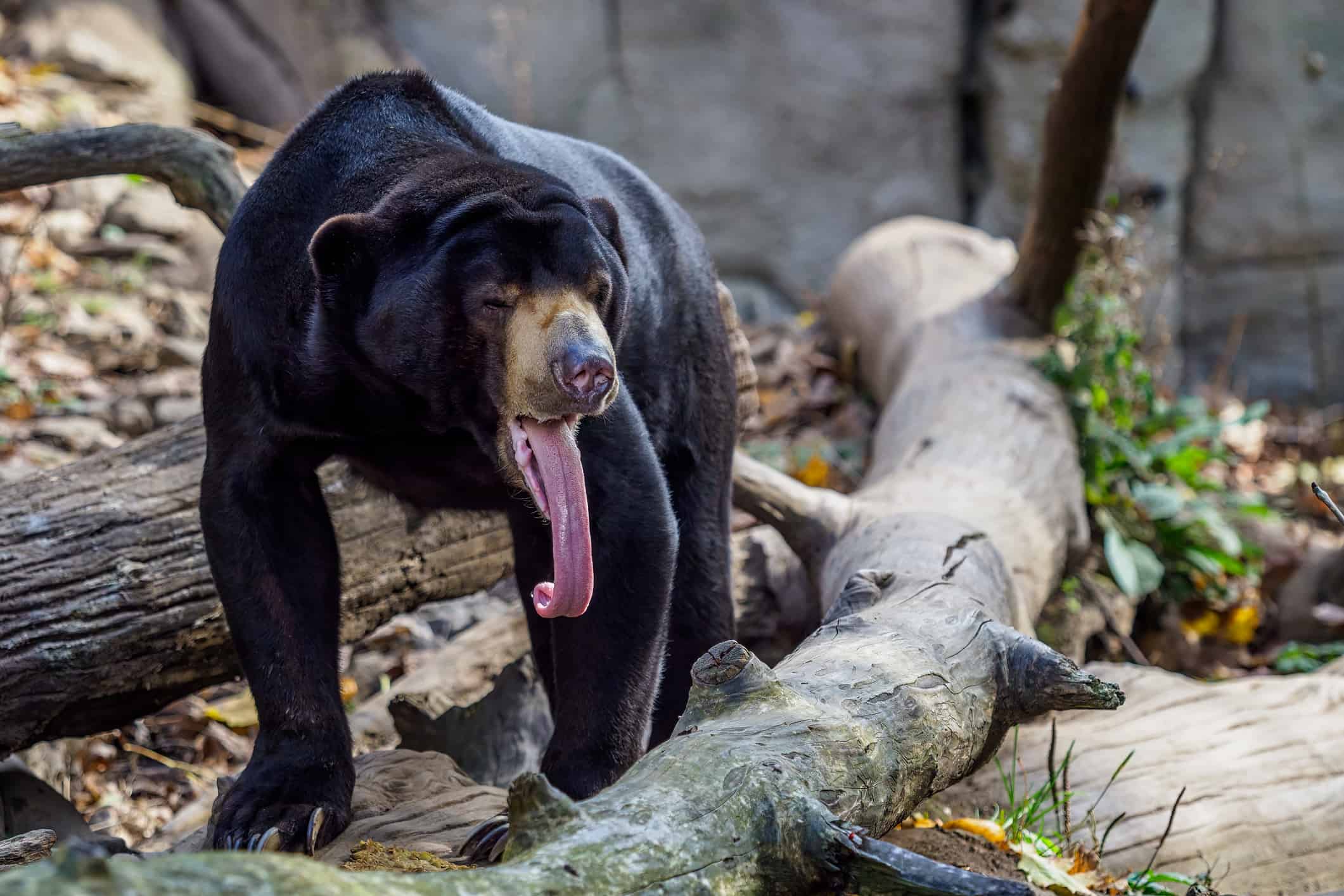
This rare Sun Bear, showing its tongue, is protected by anti-poaching laws, but still endangered by deforestation.
©iStock.com/xtrekx
Conservation Status and Life Today
Today, the Sun Bear is listed by the IUCN as an animal that is Vulnerable in its natural environment and is therefore at risk from becoming extinct in the wild in the future. The elusive nature of the Sun Bear makes it difficult for anyone to really know exactly how threatened they are, but populations are thought to have fallen by up to 30% in the past few decades. Sun Bear numbers are still declining. and although their exact population numbers are unknown, there could be less than 1,000 individuals left in the wild today. Although illegal deforestation is harder to control, Sun Bears are at least protected by anti-poaching laws to help prevent so many being hunted.
Types
The Sun Bear is considered a monotypic species; that is, there are no subspecies that have developed from it. However, there are two proposed, but not yet recognized, subspecies: The Malayan Sun Bear (from Malaysia) and the Bornean Sun Bear (from Borneo). The Bornean type has a smaller skull, but otherwise any differences are slight and still under scientific study. Since there are so few Sun Bears in existence, and since they hide so well in the forest, it is hard to ascertain from the few if there are truly any unique subspecies.
View all 293 animals that start with SSun Bear FAQs (Frequently Asked Questions)
Are Sun Bears herbivores, carnivores, or omnivores?
Sun Bears are Omnivores, meaning they eat both plants and other animals.
What Kingdom do Sun Bears belong to?
Sun Bears belong to the Kingdom Animalia.
What class do Sun Bears belong to?
Sun Bears belong to the class Mammalia.
What phylum to Sun Bears belong to?
Sun Bears belong to the phylum Chordata.
What family do Sun Bears belong to?
Sun Bears belong to the family Ursidae.
What order do Sun Bears belong to?
Sun Bears belong to the order Carnivora.
What type of covering do Sun Bears have?
Sun Bears are covered in Fur.
What genus do Sun Bears belong to?
Sun Bears belong to the genus Helarctos.
Where do Sun Bears live?
Sun Bears live in southeast Asia.
In what type of habitat do Sun Bears live?
Sun Bears live in primarily lowland tropical forests.
What are some predators of Sun Bears?
Predators of Sun Bears include tigers, snakes, and birds of prey.
How many babies do Sun Bears have?
The average number of babies a Sun Bear has is 2.
What is an interesting fact about Sun Bears?
Sun Bears are the smallest species of bear in the world!
What is the scientific name for the Sun Bear?
The scientific name for the Sun Bear is Helarctos malayanus.
What is the lifespan of a Sun Bear?
Sun Bears can live for 15 to 30 years.
How many species of Sun Bear are there?
There are 2 species of Sun Bear.
What is the biggest threat to the Sun Bear?
The biggest threats to the Sun Bear are hunting and habitat loss.
What is another name for the Sun Bear?
The Sun Bear is also called the Malaysian sun bear, Malay bear, honey bear, or dog bear.
How many Sun Bears are left in the world?
The population size of the Sun Bear is unknown.
How fast is a Sun Bear?
A Sun Bear can travel at speeds of up to 30 miles per hour.
What are the differences between sun bear and moon bear?
The greatest differences between a moon bear and a sun bear are their morphology and behavior. Moon bears are solitary creatures that are aggressive towards humans and hibernate in colder climates, possess longer black fur than a sun bear as well as a V-shaped marking on their chest, and have large bell-shaped ears along with a light brown muzzle. Sun bears do not hibernate and rarely have fatal encounters with humans, possess short black fur, small ears, a short snout, and a U-shaped or semi-circle patch of white or orange fur on their chests.
What are the differences between the sun bear and the sloth bear?
The biggest differences between a sloth bear and a sun bear lie in their morphology and behavior.
How to say Sun Bear in ...
Thank you for reading! Have some feedback for us? Contact the AZ Animals editorial team.
Sources
- David Burnie, Dorling Kindersley (2011) Animal, The Definitive Visual Guide To The World's Wildlife
- Tom Jackson, Lorenz Books (2007) The World Encyclopedia Of Animals
- David Burnie, Kingfisher (2011) The Kingfisher Animal Encyclopedia
- Richard Mackay, University of California Press (2009) The Atlas Of Endangered Species
- David Burnie, Dorling Kindersley (2008) Illustrated Encyclopedia Of Animals
- Dorling Kindersley (2006) Dorling Kindersley Encyclopedia Of Animals
- David W. Macdonald, Oxford University Press (2010) The Encyclopedia Of Mammals
- About Sun Bears, Available here: http://www.honoluluzoo.org/sun_bear.htm
- Sun Bear Information, Available here: http://www.iucnredlist.org/apps/redlist/details/9760/0

















